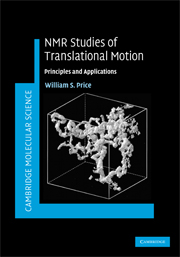Book contents
- Frontmatter
- Contents
- Preface
- Acknowledgements
- Abbreviations
- 1 Diffusion and its measurement
- 2 Theory of NMR diffusion and flow measurements
- 3 PGSE measurements in simple porous systems
- 4 PGSE measurements in complex and exchanging systems
- 5 PGSE hardware
- 6 Setup and analysis of PGSE experiments
- 7 PGSE hardware and sample problems
- 8 Specialised PGSE and related techniques
- 9 NMR imaging studies of translational motion
- 10 B1 gradient methods
- 11 Applications
- Appendix
- Index
- References
4 - PGSE measurements in complex and exchanging systems
Published online by Cambridge University Press: 06 August 2010
- Frontmatter
- Contents
- Preface
- Acknowledgements
- Abbreviations
- 1 Diffusion and its measurement
- 2 Theory of NMR diffusion and flow measurements
- 3 PGSE measurements in simple porous systems
- 4 PGSE measurements in complex and exchanging systems
- 5 PGSE hardware
- 6 Setup and analysis of PGSE experiments
- 7 PGSE hardware and sample problems
- 8 Specialised PGSE and related techniques
- 9 NMR imaging studies of translational motion
- 10 B1 gradient methods
- 11 Applications
- Appendix
- Index
- References
Summary
Introduction
A requirement in measuring transport (e.g., transmembrane) or exchange (e.g., ligand binding) is to be able to identify a measurable NMR parameter that has a different value in each state. Modulation of this parameter by the transport or exchange process is examined to characterise the process. Traditionally, NMR chemical shifts or relaxation times have been used for this purpose. With the advent of PGSE methods, a difference in diffusion properties (i.e., a difference in diffusion coefficient between sites or a difference in motional restriction) becomes another measurable NMR parameter that can be used to probe transport or exchange.
In the simplest case the exchange will occur between two freely diffusing sites (e.g., a ligand binding to a macromolecule; Figure 4.1); however, in many real systems (e.g., a suspension of biological cells) one site, or both sites if at higher cellular volume fractions, may be restricted. In contrast to the previous chapter where only simple restricting systems with reflecting boundary conditions were considered and the diffusing species did not interact with other restricting geometries, in real systems (e.g., biological cells, porous systems) it may also be necessary to consider the effects of a combination of exchange, restriction, obstruction and polydispersity in addition to surface and bulk relaxation as well as different bulk diffusion coefficients in each medium (e.g., Figure 4.2). As a consequence, modelling such systems can be very complicated and various approximations are necessarily used.
- Type
- Chapter
- Information
- NMR Studies of Translational MotionPrinciples and Applications, pp. 147 - 184Publisher: Cambridge University PressPrint publication year: 2009

